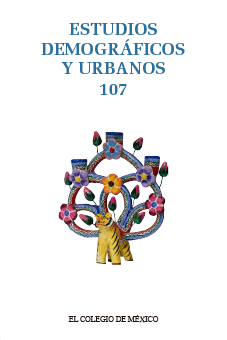Brecha de género en la participación laboral y el tipo de unión conyugal en Argentina
Publicado 2021-05-07
Palabras clave
- usos del tiempo,
- género,
- participación económica,
- Argentina.
Cómo citar
-
Resumen1513
-
PDF (español)564
-
En línea (español)190
Descargas
Derechos de autor 2021 Estudios Demográficos y Urbanos

Esta obra está bajo una licencia internacional Creative Commons Atribución-NoComercial-SinDerivadas 4.0.
Métrica
Resumen
En este artículo se analiza el posible efecto de la división de tareas dentro de los hogares conformados por parejas unidas y casadas sobre sus niveles e intensidades de participación en el mercado de trabajo. Con datos del Módulo de Uso del Tiempo, añadido a la Encuesta Anual de Hogares Urbanos del año 2013, se explora empíricamente la siguiente hipótesis: los hogares formados por parejas unidas distribuyen las tareas domésticas (no remuneradas) más igualitariamente que aquellos de parejas casadas, lo que conduce a una participación laboral más parecida tanto en incidencia como en intensidad de participación. Dicho de otra manera, mujeres y hombres casados tienden a una especialización mayor y, por lo tanto, se observa en estas parejas una brecha de participación entre géneros más amplia que la registrada entre mujeres y hombres unidos de hecho.
Referencias
- Abraham, K. y Mackie, C. (eds.) (2005). Beyond the market: Designing nonmarket accounts for the United States. Panel to study the design of nonmarket accounts. Washington, D.C: National Research Council of the National Academies.
- Aguirre, R., García Sainz, C. y Carrasco, C. (2005). El tiempo, los tiempos, una vara de desigualdad. (Documento de trabajo, núm. 65). Serie Mujer y Desarrollo. Santiago de Chile: CEPAL. https://repositorio.cepal.org/bitstream/handle/11362/5936/1/S055367_es.pdf
- Arosio, L. (2017). Marriage, cohabitation and participation in domestic labor: Men and women in contemporary Italy. European Scientific Journal, 13(8), 236-249. https://eujournal.org/index.php/esj/article/view/8998/8563 DOI: https://doi.org/10.19044/esj.2017.v13n8p236
- Barg, K. y Beblo, M. (2012). Does “sorting into specialization”. Explain the differences in time use between married and cohabiting couples? An empirical application for Germany. Annals of Economics and Statistics, 105/106, 127-152. https://ideas.repec.org/a/adr/anecst/y2012i105-106p127-152.html DOI: https://doi.org/10.2307/23646459
- Baxter, J. (2005). To marry or not to marry: Marital status and the household division of labor. Journal of Family Issues, 26(3), 300-321. https://www.researchgate.net/deref/http%3A%2F%2Fdx.doi.org%2F10.1177%2F0192513X04270473 DOI: https://doi.org/10.1177/0192513X04270473
- Becker, G. (1965). A theory of allocation time. The Economic Journal, 75(299), 493-517. https://www.jstor.org/stable/2228949?seq=1#metadata_info_tab_contents DOI: https://doi.org/10.2307/2228949
- Becker, G. (1981). A treatise on the family. Londres: Harvard University Press.
- Bianchi, S., Lesnard, L., Nazio, T. y Raley, S. (2014). Gender and time allocation of cohabiting and married women and men in France, Italy, and the United States. Demographic Research, 31(8), 183-216. https://www.demographic-research.org/volumes/vol31/8/31-8.pdf DOI: https://doi.org/10.4054/DemRes.2014.31.8
- Blair, S. y Lichter, T. (1991). Measuring the division of household labor: Gender segregation of housework among American couples. Journal of Family Issues, 12(1), 91-113. https://www.researchgate.net/deref/http%3A%2F%2Fdx.doi.org%2F10.1177%2F019251391012001007 DOI: https://doi.org/10.1177/019251391012001007
- Blau, F., Ferber, M. y Winkler, A. (2014). The economics of the women, men, and work. Londres: Prentice Hall.
- Bloemen, H., Pasqua, S. y Stancanelli, E. (2010). An empirical analysis of the time allocation of Italian couples: Are they responsive? Review of Economics of the Household, 8(3), 345-369. https://link.springer.com/article/10.1007/s11150-009-9083-4 DOI: https://doi.org/10.1007/s11150-009-9083-4
- Browning, M., Chiappori, P. y Weiss, Y. (2014). Economics of the family. Nueva York: Cambridge University Press. DOI: https://doi.org/10.1017/CBO9781139015882
- Bryant, K. y Zick, C. (2006). The economic organization of the household. Londres: Cambridge University Press. DOI: https://doi.org/10.1017/CBO9780511754395
- Cherlin, A. (2004). The deinstitutionalization of American marriage. Journal of Marriage and Family, 66(4), 848-861. https://onlinelibrary.wiley.com/doi/full/10.1111/j.0022-2445.2004.00058.x DOI: https://doi.org/10.1111/j.0022-2445.2004.00058.x
- Davis, S., Greenstein, T. y Gerteisen, J. (2007). Effects of union type on division of household labor: Do cohabiting men really perform more housework? Journal of Family Issues, 28(9), 1246-1272. https://www.researchgate.net/deref/http%3A%2F%2Fdx.doi.org%2F10.1177%2F0192513X07300968 DOI: https://doi.org/10.1177/0192513X07300968
- Domínguez-Folgueras, M. (2012a). La división del trabajo doméstico en las parejas españolas. Un análisis del uso del tiempo. Revista Internacional de Sociología, 70(1), 153-179. http://revintsociologia.revistas.csic.es/index.php/revintsociologia/article/view/439 DOI: https://doi.org/10.3989/ris.2009.08.26
- Domínguez-Folgueras, M. (2012b). Is cohabitation more egalitarian? The division of household labor in five European countries. Journal of Family Issues, 34(12), 1623-1646. https://hal-sciencespo.archives-ouvertes.fr/hal-01024517 DOI: https://doi.org/10.1177/0192513X12464948
- Esplen, E. (2009). Género y cuidados: una mirada general. En Breve, Boletín de Bridge, 20. http://americalatinagenera.org/newsite/images/cdr-documents/publicaciones/enbrevegeneroycuidados2009.pdf
- Esquivel, V. (2009). Uso del tiempo en la Ciudad de Buenos Aires. Los Polvorines: Universidad Nacional de General Sarmiento.
- García, B. (2019). El trabajo doméstico y de cuidado: su importancia y principales hallazgos en el caso mexicano. Estudios Demográficos y Urbanos, 34(2), 237-267. https://estudiosdemograficosyurbanos.colmex.mx/index.php/edu/article/view/1811/pdf DOI: https://doi.org/10.24201/edu.v34i2.1811
- García, B. y De Oliveira, O. (2007). Trabajo extradoméstico y relaciones de género: una nueva mirada. En M. Gutiérrez (ed.), Género, familias y trabajo: rupturas y continuidades. Desafíos para la investigación política (pp. 49-87). Buenos Aires: Consejo Latinoamericano de Ciencias Sociales.
- Gronau, R. (1976). Leisure, home production and work. The theory of allocation of time revisited. Journal of Political Economy, 85(6), 1099-1123. https://www.jstor.org/stable/1837419?seq=1#metadata_info_tab_contents DOI: https://doi.org/10.1086/260629
- Henkens, K., Grift, Y. y Siegers, J. (2002). Changes in female labour supply in the Netherlands 1989-1998: The case of married and cohabiting women. European Journal of Population, 18(1), 39-57. https://link.springer.com/article/10.1023/A:1013868021024 DOI: https://doi.org/10.1023/A:1013868021024
- Hoem, J. (2005). Why does Sweden have such high fertility? (Documento de Trabajo, WP-2005-009). Alemania: Max Planck Institute for Demographic Research. https://www.demogr.mpg.de/papers/working/wp-2005-009.pdf DOI: https://doi.org/10.4054/MPIDR-WP-2005-009
- International Labour Office. (ILO). (2017). World employment and social outlook: Trends for women 2017. Ginebra: International Labour Office. https://www.ilo.org/global/research/global-reports/weso/trends-for-women2017/lang--en/index.htm
- Killingsworth, R. y Heckman, J. (1986). Female labor supply: A survey. En O. Ashenfelter y R. Layard (eds.), Handbook of labor economics, vol. 1 (pp. 103-204). Amsterdam: North-Holland. DOI: https://doi.org/10.1016/S1573-4463(86)01005-2
- Kuperberg, A. (2012). Reassessing differences in work and income in cohabitation and marriage. Journal of Marriage and Family, 74(4), 688-707. https://www.jstor.org/stable/41678750?seq=1#metadata_info_tab_contents DOI: https://doi.org/10.1111/j.1741-3737.2012.00993.x
- Martínez, C., Miller, T. y Saad, P. (2013). Participación laboral femenina y bono de género en América Latina. (Documento de Proyecto, núm. LC/W.570). Santiago de Chile: CEPAL-CELADE. https://repositorio.cepal.org/bitstream/handle/11362/35897/1/S20131095_es.pdf
- Meggiolaro, S. (2014). Household labor allocation among married and cohabiting couples in Italy. Journal of Family Issues, 35(6), 851-876. https://www.researchgate.net/deref/http%3A%2F%2Fdx.doi.org%2F10.1177%2F0192513X13491409 DOI: https://doi.org/10.1177/0192513X13491409
- Paz, J. (2018). Ensayos sobre el bono de género en la Argentina. Factores internos y externos que determinan la participación económica femenina. (Tesis doctoral, Universidad Nacional de Córdoba). https://rdu.unc.edu.ar/handle/11086/6723
- Sánchez Peña, L. y Pérez Amador, J. (2016). Distintas o iguales: las diferencias en el trabajo doméstico de las parejas de doble ingreso entre las uniones libres y los matrimonios. Estudios Demográficos y Urbanos, 31(3), 593-634. https://estudiosdemograficosyurbanos.colmex.mx/index.php/edu/article/view/11/pdf DOI: https://doi.org/10.24201/edu.v31i3.11
- Shelton, B. y John, D. (1993). Does marital status make a difference? Journal of Family Issues, 14(3), 401-420. https://journals.sagepub.com/doi/pdf/10.1177/019251393014003004 DOI: https://doi.org/10.1177/019251393014003004
- South, J. y Spitze, G. (1994). Housework in marital and nonmarital households. American Sociological Review, 59(3), 327-347. https://psycnet.apa.org/record/1995-40239-001 DOI: https://doi.org/10.2307/2095937
- Stewart, J. (2009). Tobit or not tobit? (Documento de Trabajo, núm. 4588). Alemania. Institute of Labor Economics. http://ftp.iza.org/dp4588.pdf DOI: https://doi.org/10.2139/ssrn.1515135
- Stiglitz, J., Sen, A. y Fitoussi, J. P. (2009). Report by the Commission on the Measurement of Economic Performance and Social Progress. https://www.researchgate.net/publication/258260767_Report_of_the_Commission_on_the_Measurement_of_Economic_Performance_and_Social_Progress_CMEPSP
- Torns, T. (2004). Las políticas de tiempo: un reto para las políticas del estado de bienestar. Trabajo. Revista Iberoamericana de Relaciones Laborales, 13, 145-164. https://dialnet.unirioja.es/servlet/articulo?codigo=1039489 DOI: https://doi.org/10.33776/trabajo.v13i0.146



